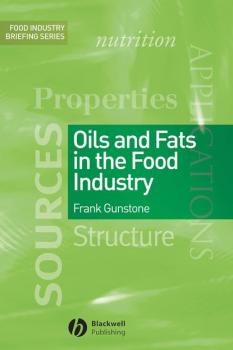ТОП просматриваемых книг сайта:
Frank Gunstone
Список книг автора Frank GunstoneАннотация
Rapeseed is now the second largest oilseed crop after soybean, and the third largest vegetable oil after soybean oil and palm oil, and it is therefore an important contributor to the annual supply of vegetable oils required to meet an increasing demand. This volume provides comprehensive coverage of rapeseed oil and its close relative, canola oil, from production (agronomic) aspects, through extraction to refining and processing. Chemical composition, physico-chemical properties, food and non-food uses are considered in detail, and a chapter is included on future prospects, including oils available by means of genetic manipulation. This is a book for oils and fats chemists and technologists in the food and oleochemical industries, chemical engineers in the processing industry, nutritionists and seed technologists.
Аннотация
Oils and fats are almost ubiquitous in food processing – whether naturally occurring in foods or added as ingredients for functional benefits and, despite the impression given by several sources to the contrary, they remain an essential part of the human diet. However, it is increasingly apparent that both the quantity and the quality of the fat consumed are vital to achieving a balanced diet. Health concerns regarding high-fat diets continue to have a high profile, and still represent a pressing issue for food manufacturers. This volume provides a concise and easy-to-use reference on the nature of oils and fats for those working in the food industry and for those in the media seeking to advise the public on consumption. Written in a style that makes the concepts and information contained easily accessible, and using a minimum of chemical structures, the nature and composition of the constituents of oils and fats are explained. The major sources of food lipids (vegetable and animal fats) are outlined, along with their physical characteristics. The book also focuses on the current main concerns of the food industry regarding oils and fats use, including: the nutritional properties of fats and oils and their various components; links between chemical structure and physiological properties; and the role of lipids in some of the more important disease conditions such as obesity, diabetes, coronary heart disease and cancer. The final chapter is devoted to a description of the most common food uses of oils and fats. The book will be of interest to food industry professionals, students or others who require a working knowledge of oils and fats in the food industry.
Аннотация
The three major macronutrients are proteins, carbohydrates, and lipids (oils and fats). This book is devoted to lipids, which are an important part of life for all of us. What are these materials in molecular terms? Where do they come from? What happens to them between the harvesting of crops and the appearance of the oils and fats in different products in the supermarket? How does nature produce these molecules and can we act on nature to modify the materials to increase their beneficial properties? How important are the minor products present in the fats that we consume? Since oils and fats vary, how can we analyse them? What are their physical, chemical and nutritional properties? How do the fats that we consume affect our health and well-being in both quantitative and qualitative terms? What are their major food and non-food uses? This book provides a broad source of reference on oils and fats chemistry for graduates entering the food and oleochemical industries, postgraduate researchers and nutritionists. It offers a point of entry to the detailed literature.



